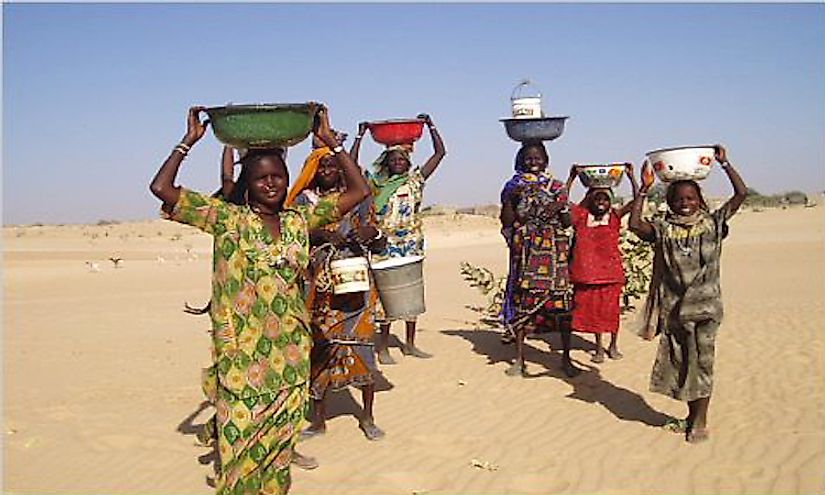Largest Ethnic Groups Of Chad

Chad is a country in central Africa located south of Libya. The population in the country is unevenly distributed because of the contrast in physical geography and climate. The south western part of the country around Lake Chad is highly populated, whereas the Northern part of the country is the dry Saharan zone, which is sparsely populated. Among hundreds of ethnic groups in Chad, the Sara and Arabs are the two most populous. The population of Chad is a unique mix of native communities and Arabs who invaded the region from the 8th century. The Arabs introduced the Islam religion, and the population is also divided between Muslims and non-Muslims. Approximately 180 ethnic groups reside in Chad and over 100 languages are spoken in the country.
Largest Ethnic Groups Of Chad
Sara
The largest ethnic group is the Sara, representing 28% of the country’s population. The Sara people trace their ancestry to the Sao, who were displaced from the north-east banks of the Nile River by Arab slave traders and settled in Chad in the 16th century. They are patrilineal and non-Muslim, with significant population still practicing traditional faiths. The ethnicity prides in 12 sub-tribes including the Sar, Mbay, Kaba, Gulay, Dai, and the Ngambay. The group’s language is classified under the Nilo-Saharan family. The Sara occupy the southern parts of the country, between the Logone River and Lake Iro. They mostly engage in farming for products such as cotton, cassava, and millet. During colonization, southern Chad was the center of administration for the French Rule. The Sara were thus more assimilated and educated than their northern counterparts. Their most notable culture is the body scarring rituals used as a form of body art.
Arab
The Arabs make up 12% of Chad’s population. They are semi-sedentary and mostly occupy the Ouaddai and Chari Baguirmi regions in the country. Their presence can be traced back to the Arab invasions in the area and the subsequent conversions to Islam. The group is divided into three subgroups namely the Hassuna, the Juhayna, and the Awlad Sulayman. The group’s social structure revolves around the Kashimbet led by an elder male. During colonization, the Arabs resisted French Rule, and their culture remained largely unaltered. The Chadian Arabs have been involved in resistance against the central government from time to time.
Daza
The Daza ethnic group has an 11% share of the population in Chad. Islam is the main religion of the population which inhabits the Sahara Desert’s southern fringes. Their social structure is organized along clans and tribes headed by chiefs. The Daza are known for their skills in fighting, and they have resisted countless invasions. The encroaching desert has caused them to move to towns and cities to look for employment as are traditionally nomads.
Mayo-Kebbi
The Mayo-Kebbi people make up 10% of Chad’s population. The group lives in proximity to the Sara people in the country’s southwestern region. The group’s name is derived from the name of the valley that they inhabit. The Mayo-Kebbi is not Muslim, and they mainly observe indigenous beliefs.
Other Ethnic Groups In Chad
The rest of Chad’s ethnic groups are the Kanem-Bornou (9%); Ouaddai (9%); Hadjarai (7%); Tandjilé (7%), and Fitri-Batha (5%). Other groups makeup 2% of the population and include the Gorane, Fulani, Karo, Katoko, Maba, Massa, Mbaye, and Moundang. Non-indigenous ethnicities in Chad include the Sudanese and the French.
Largest Ethnic Groups Of Chad
| Rank | Ethnic Group | Share of Population in Chad |
| 1 | Sara | 28% |
| 2 | Arab | 12% |
| 3 | Daza | 11% |
| 4 | Mayo-Kebbi | 10% |
| 5 | Kanem-Bornou | 9% |
| 6 | Ouaddaï | 9% |
| 7 | Hadjarai | 7% |
| 8 | Tandjilé | 7% |
| 9 | Fitri-Batha | 5% |
| Other Groups | 2% |







